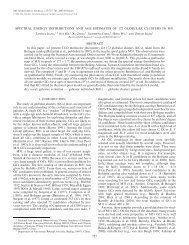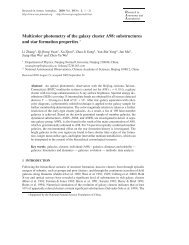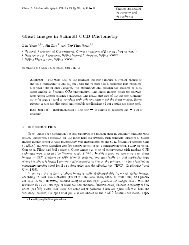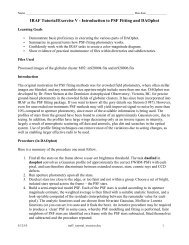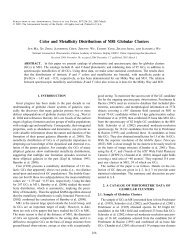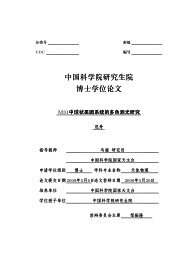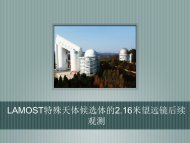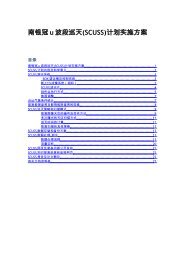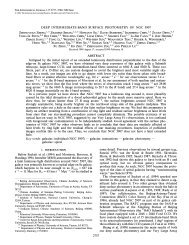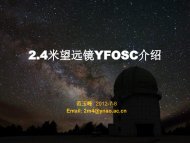Wu,H.,Deng,Z.G.,Chen,J.S.,Zhou,X.,et al,2002 ... - BATC home page
Wu,H.,Deng,Z.G.,Chen,J.S.,Zhou,X.,et al,2002 ... - BATC home page
Wu,H.,Deng,Z.G.,Chen,J.S.,Zhou,X.,et al,2002 ... - BATC home page
You also want an ePaper? Increase the reach of your titles
YUMPU automatically turns print PDFs into web optimized ePapers that Google loves.
No. 3, <strong>2002</strong> PHOTOMETRY OF NGC 4565 1369<br />
Fig. 3.—Four slices of the background-subtracted 6660 Å image to show the accuracy of the sky-background fit. Each slice is averaged over 35 lines of the<br />
image, and only nonmasked pixels are used. If <strong>al</strong>l 35 points are masked, a zero v<strong>al</strong>ue is assigned. The straight lines indicate the zero level. (a) Eight arcminutes<br />
southeast of the minor axis. (b) Eight arcminutes northwest of the minor axis. (c) Eight arcminutes southwest of the major axis. (d ) Eight arcminutes northeast<br />
of the major axis. The large-sc<strong>al</strong>e variation of background subtraction is sm<strong>al</strong>l. The disk of NGC 4565 is seen in the centers of slices a and b. The wings of<br />
subtracted stars are <strong>al</strong>so evident in these slices.<br />
size (our largest bin size) and 130.6 e for a region 8<br />
pixels 3 pixels in size (our sm<strong>al</strong>lest bin size).<br />
Dark-current noise.—The dark current of our combined<br />
image of 42.79 hr is 128.3 e pixel 1 . This introduces random<br />
noise of 11.3 e pixel 1 . For the sm<strong>al</strong>lest and largest<br />
bins, this v<strong>al</strong>ue reduces to 2.3 e and 0.27 e separately.<br />
Bias-subtraction noise.—Since the readout noise is 12 e<br />
pixel 1 and 200 to 300 bias frames are used to form fin<strong>al</strong><br />
average bias, the error from bias subtraction is about 0.8 e<br />
pixel 1 , yielding 0.02 e pixel 1 for the region of 35<br />
pixels 50 pixels and 0.17 e for the sm<strong>al</strong>lest bins used<br />
here.<br />
Flat field: Random and systematic noise.—The averaged<br />
nightly flat used here is comprised of 12 dome flats with tot<strong>al</strong><br />
counts of about 840,000 e pixel 1 , yielding a photon<br />
noise close to 0.1%, or 330.1 e pixel 1 equiv<strong>al</strong>ent skybackground<br />
counts. Given that that fin<strong>al</strong> image includes<br />
150 shifted, averaged flats, the error per pixel is reduced to<br />
0.009%. This part of the flat-field error is random in nature<br />
and translates to a form<strong>al</strong> error of 0.0002% for the largest<br />
sample bins used here, to 0.0018% for the sm<strong>al</strong>lest bins.<br />
The stability of the large-sc<strong>al</strong>e flat field was checked by<br />
comparing the dome flats from adjacent nights. The average<br />
results of these tests indicate an error of 0.03%, or close to<br />
90 e pixel 1 for our measured sky background. In our<br />
CCD system, the opening and closing time of the shutter is<br />
20 ms and the exposure time of each dome flat is 150 s. So<br />
there exists a 0.013% gradient due to finite shutter speed in<br />
the each dome-flat frame. Combining these two s<strong>et</strong>s of<br />
errors, we estimate that the error from systematic variations<br />
in the large-sc<strong>al</strong>e flat field is 0.033%, equiv<strong>al</strong>ent to 100 e<br />
pixel 1 of the sky background.<br />
Intrinsic variation in g<strong>al</strong>axy brightness.—Following Morrison<br />
<strong>et</strong> <strong>al</strong>. (1994) and Zheng <strong>et</strong> <strong>al</strong>., we can c<strong>al</strong>culate the random<br />
error due to intrinsic variation in the surface brightness<br />
of the g<strong>al</strong>axy. In the terminology introduced by Tonry &<br />
Schneider (1988), m 1 for our image is 20.30 mag, the exposure<br />
time is 154,043 s, the distance is 14.5 Mpc, and M 6660 is<br />
adopted as 0 (Zheng <strong>et</strong> <strong>al</strong>. 1999). In the case of 300 e<br />
pixel 1 from the g<strong>al</strong>axy (equ<strong>al</strong> to a surface brightness of<br />
28.23 mag arcsec 2 ), this error is 53.8 e pixel 1 , or an error<br />
of 18%. This translates to an average error of 1.29 e for the<br />
largest bins used here and to 10.98 e for the sm<strong>al</strong>lest bins.<br />
Background subtraction.—There are two types of background-subtraction<br />
errors, both dominated by systematic<br />
effects. One is the accuracy of the sky-background subtraction,<br />
for which we adopt the v<strong>al</strong>ue of 115 e obtained above.<br />
The second comes from imperfect star subtraction, especi<strong>al</strong>ly<br />
for saturated stars. For this we adopt an average error<br />
of 100 e pixel 1 by checking the regions in which stars are<br />
subtracted. We acknowledge that this error can be significantly<br />
higher for selected stars, especi<strong>al</strong>ly for the saturated<br />
stars that are so close to NGC 4565. For the true errors<br />
involved in star subtraction, we must look to the consistency<br />
of the luminosity profiles at faint surface brightness levels.<br />
3.4. The Tot<strong>al</strong> Error Budg<strong>et</strong><br />
All the sources of errors discussed are listed in Table 2.<br />
We assume that the mean count per pixel from the object<br />
g<strong>al</strong>axy is 300 e (i.e., in its faint h<strong>al</strong>o), a sky level of 302,500<br />
e , and bin sizes of 35 pixels 50 pixels and 8 pixels 3 pixels<br />
for surface photom<strong>et</strong>ry. This leads to a fin<strong>al</strong> error of<br />
close to 400 e pixel 1 . Errors for each bin are c<strong>al</strong>culated<br />
based on the number of nonmasked pixels in that bin, ratioed<br />
to the error expected for <strong>al</strong>l pixels in that bin having<br />
data.<br />
Since photon noise in the sky is the dominant source of<br />
error in our data, we give the expected error per bin for both<br />
the sm<strong>al</strong>lest bin that we use for R-profiles (8 pixels 3 pixels)<br />
and the largest bin that we use for z-profiles (35<br />
pixels 50 pixels). The error for the faintest part of NGC<br />
4565 is close to 183 e pixel 1 ,or63e arcsec 2 . That is, the<br />
relative error of measured flux at 28.77 mag arcsec 2 is<br />
100%, leading to an error bar of 0.75 mag arcsec 2 . This <strong>al</strong>so<br />
corresponds to an error of 0.25 mag arcsec 2 at a surface<br />
brightness of 27.5 mag arcsec 2 . In fact, the error is a little<br />
higher than this, because there exist masked regions in the




